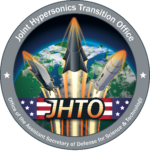![In the midst of various United States government, academic, and industry projects exploring and pursuing hypersonic technology for defense, Gillian Bussey, director of the Defense Department’s Joint Hypersonics Transition Office notes that China has long been pursuing hypersonic and “near space” weapons and technology for a number of years now and the United States Department of Defense needs to “focus on offense, first, because a good offense is the best defense—and offense is a lot easier.” This race for hypersonic defense includes small are large weapons as mentioned by Mark Lewis who is the executive director of the National Defense Industrial Association’s Emerging Technologies Institute who urges the endurance needed in this race for hypersonics “This can’t be a few years’ effort [where] we deploy a couple of systems, and then move on Because this is the future of warfare and we need to be in this race.” There are many different United States industry, universities and military resources being teamed to create hypersonic defense solutions currently and there are still many scientific breakthroughs to come in the field of hypersonics. Read more about this on Defense One.](https://hypersonics.tamu.edu/wp-content/uploads/2022/02/GettyImages-1146899896-300x200.jpg) In the midst of various United States government, academic, and industry projects exploring and pursuing hypersonic technology for defense, Gillian Bussey, director of the Defense Department’s Joint Hypersonics Transition Office notes that China has long been pursuing hypersonic and “near space” weapons and technology for a number of years now and the United States Department of Defense needs to “focus on offense, first, because a good offense is the best defense—and offense is a lot easier.” This race for hypersonic defense includes small as well as large weapons says Mark Lewis who is the executive director of the National Defense Industrial Association’s Emerging Technologies Institute. Mark urged the endurance needed in this race for hypersonics “[t]his can’t be a few years’ effort [where] we deploy a couple of systems, and then move on. Because this is the future of warfare and we need to be in this race.” There are many different United States industry, universities and military resources teaming together to create hypersonic defense solutions currently and there are still many scientific breakthroughs to come in the field of hypersonics. Read more about this on Defense One.
In the midst of various United States government, academic, and industry projects exploring and pursuing hypersonic technology for defense, Gillian Bussey, director of the Defense Department’s Joint Hypersonics Transition Office notes that China has long been pursuing hypersonic and “near space” weapons and technology for a number of years now and the United States Department of Defense needs to “focus on offense, first, because a good offense is the best defense—and offense is a lot easier.” This race for hypersonic defense includes small as well as large weapons says Mark Lewis who is the executive director of the National Defense Industrial Association’s Emerging Technologies Institute. Mark urged the endurance needed in this race for hypersonics “[t]his can’t be a few years’ effort [where] we deploy a couple of systems, and then move on. Because this is the future of warfare and we need to be in this race.” There are many different United States industry, universities and military resources teaming together to create hypersonic defense solutions currently and there are still many scientific breakthroughs to come in the field of hypersonics. Read more about this on Defense One.


